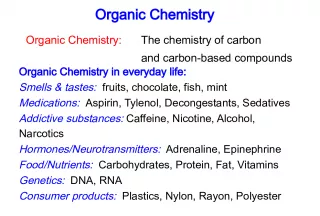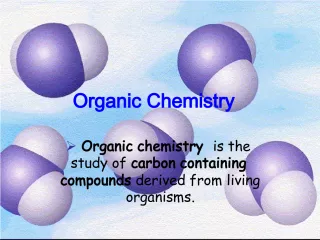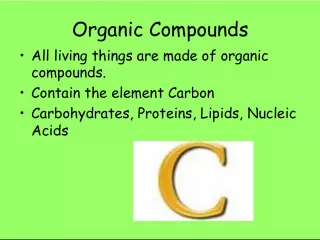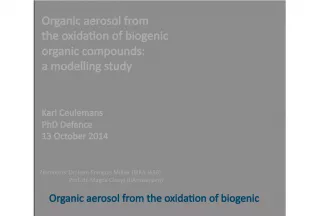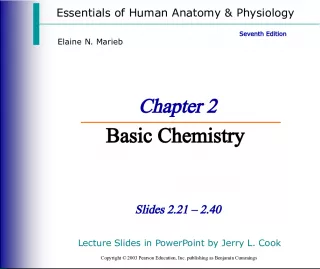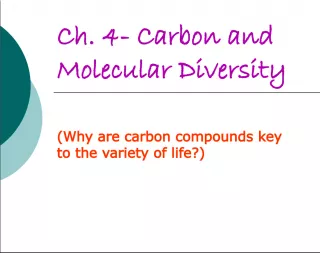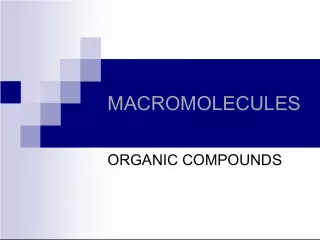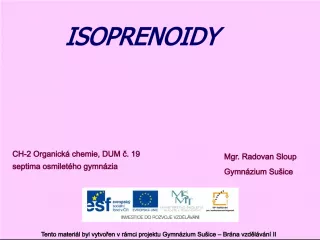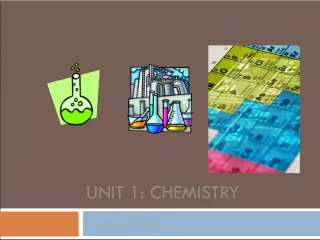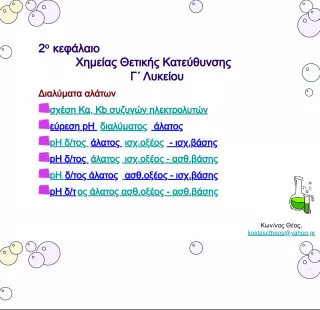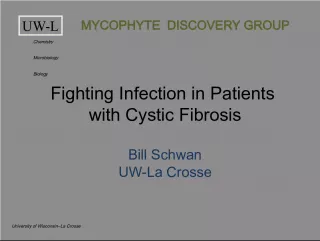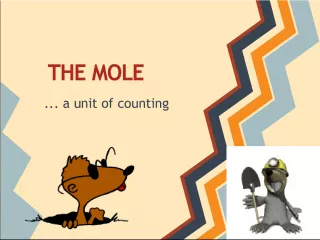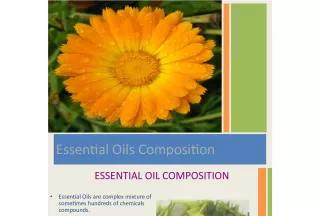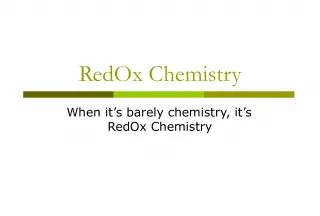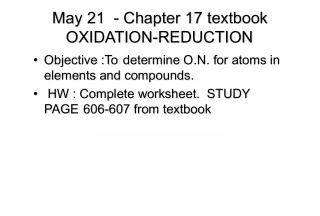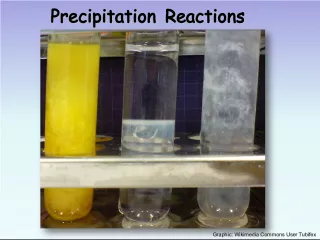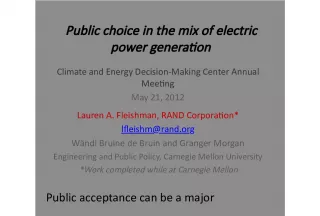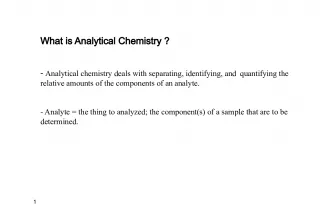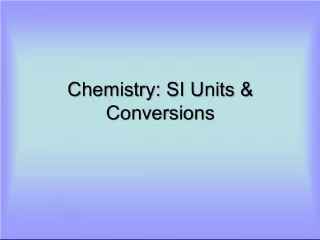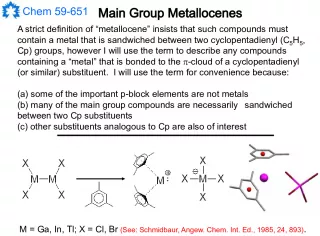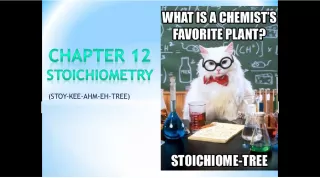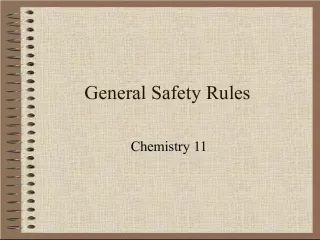Organic Chemistry: The Study of Carbon and its Compounds
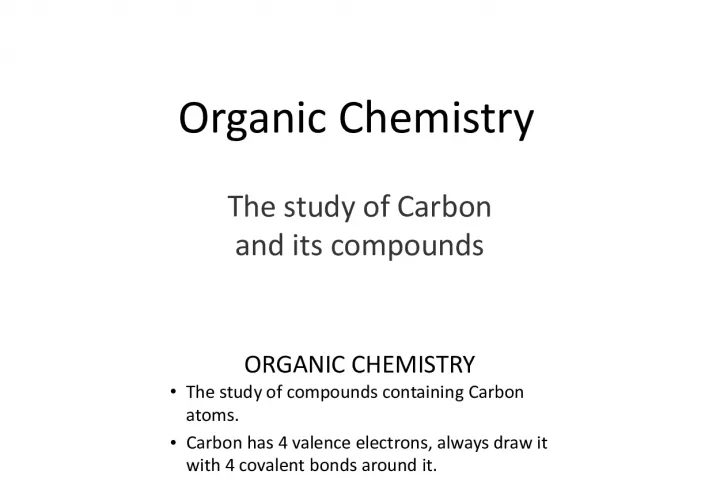

Organic chemistry involves the study of compounds that contain carbon atoms. Carbon has four valence electrons and typically forms tetrahedral shapes when it bonds. Most organic compounds are nonpolar and insoluble in water, but soluble in nonpolar solvents.
- Uploaded on | 2 Views
-
 wencke
wencke
About Organic Chemistry: The Study of Carbon and its Compounds
PowerPoint presentation about 'Organic Chemistry: The Study of Carbon and its Compounds'. This presentation describes the topic on Organic chemistry involves the study of compounds that contain carbon atoms. Carbon has four valence electrons and typically forms tetrahedral shapes when it bonds. Most organic compounds are nonpolar and insoluble in water, but soluble in nonpolar solvents.. The key topics included in this slideshow are . Download this presentation absolutely free.
Presentation Transcript
Slide1Organic ChemistryThe study of Carbon and its compounds
Slide2ORGANIC CHEMISTRY• The study of compounds containing Carbon atoms. • Carbon has 4 valence electrons, always draw it with 4 covalent bonds around it. • When it forms all single bonds the shape of around the carbon is TETRAHEDRAL.
Slide3Properties• Solubility – Most nonpolar (like dissolves like) – Most compounds are insoluble in water – Soluble in non-polar solvents H O O
Slide4Properties• Most are non-electrolytes – Covalent, no conductivity – (an exception is organic acids)
Slide5Properties• Low Melting/ Boiling Points
Slide6Properties• Rate of Reaction – Slower than inorganic compounds – High activation energy
Slide7Properties• Bonding – Nonpolar covalent – Carbon has 4 valance electrons- tetrahedron – Carbon can bond with itself indefinitely (in dif. shapes, many variations) Always make 4 bonds C
Slide8HYDROCARBONS• Compounds containing only C and H. • 3 open chain families • ALKANES • ALKENES • ALKYNES
Slide9HomologousSeries or families Group of related compounds in which each member differs from the next by one carbon and 2 hydrogens
Slide10Alkanes• Single-bonded hydrocarbons • Hydrocarbon= only carbon and hydrogen atoms IUPAC name Molecular Formula Generic Formula methane CH 4 ethane C 2 H 6 propane C 3 H 8 butane C 4 H 10 pentane C 5 H 12 hexane C 6 H 14 C n H 2n+2 heptane C 7 H 16 octane C 8 H 18 nonane C 9 H 20 decane C 10 H 22 • As the molecular size and dispersion forces increase, the boiling point and freezing point increase
Slide11Table Q
Slide13Alkenes• have one Double-bonded hydrocarbon • Unsaturated • Same prefix as alkanes, with suffix -ene Dienes contain TWO double bonds, and are not alkenes!
Slide14Alkynes• one Triple-bonded hydrocarbon • Unsaturated • Same prefix as alkanes, and alkenes, with suffix - yne
Slide15Saturated vs Unsaturatedcompounds Single Bonds Double/Triple Bonds
Slide16Benzene• 6 carbon atoms in a ring Aromatic Hydrocarbon Only structure really needs to be known for the regents. Cyclic Hydrocarbons
Slide17•How to draw and name different organic compounds? • ISOMERS
Slide18Isomers• C o m p o u n d s w i t h : • t h e s a m e m o l e c u l a r f o r m u l a s • d i f f e r e n t s t r u c t u r a l f o r m u l a s C 4 H 10 Normal Butane 2-Methyl Propane Although these structures look different, they both have the same molecular formula of C 4 H 10
Slide19ISOMERS• Same molecular formula but different structural formula. Have different chemical and physical properties.
Slide20Alkyl Groups• Have 1 less hydrogen (H) than the corresponding alkane • Ex: • Methyl CH 3 – 1 less H than CH 4 • Ethyl C 2 H 5 – 1 less H than C 2 H 6
Slide21Rules for naming organic compoundsFor Straight or continuous chains: normal form n-alkanes. For branched compounds: 1.Find the longest continuous chain and name the compound. Branches are alkyl groups and end with –yl. 2. The location of the alkyl group is determined by assigning numbers to the carbon atoms of the longest chain, beginning at the end that will give the lowest number to the carbon that contains the alkyl or special group.
Slide22Drawing RulesStep 1 Step 2 -ane, Alkane: draw all single bonds -ene, Alkene: draw all single bonds except draw a double on the number carbon that is present in the name -yne, Alkyne: draw all single bonds except draw a triple bond on the number carbon that is present in the name Step 3 It’s as easy as 1, 2, 3…. Make sure all carbons have 4 bonds
Slide23Draw Hexane1 s t T a s k : Draw Hexane CCCCCC Condensed Formula: CH 3 -CH 2 -CH 2 -CH 2 -CH 2 -CH 2 -CH 3
Slide24Draw 1-Pentene2 n d T a s k : -ane, Alkane: draw all single bonds -ene, Alkene: draw all single bonds except draw a double on the number carbon that the prefix shows -yne, Alkyne: draw all single bonds except draw a triple bond on the number carbon that the prefix shows -ene, Alkene: draw all single bonds except draw a double on the number carbon that the prefix shows
Slide25Draw 2-butyne3 r d T a s k : -ane, Alkane: draw all single bonds -ene, Alkene: draw all single bonds except draw a double on the number carbon that the prefix shows -yne, Alkyne: draw all single bonds except draw a triple bond on the number carbon that the prefix shows -yne, Alkyne: draw all single bonds except draw a triple bond on the number carbon that the prefix shows -yne, Alkyne: draw all single bonds except draw a triple bond on the number carbon that the prefix shows
Slide26Draw: 2, 3-dimethylbutane
Slide27Practice Problems• Using Table Q, what type of homologous structure is this and why? Why? • General formula • Structure • Name Why? • General formula • Structure • Name
Slide28•Objective : Functional groups . • How to distinguish them and what do they do to an organic compound? • Table R
Slide29Table ROrganic compounds and their functional groups
Slide31Halides (Halocarbons)• A halide is formed when one or more halogen elements attach themselves to a chain of carbons atoms • Halogen include all the elements in group 17
Slide32Naming Halocarbons• Halocarbons are usually formed from Alkenes – This is because the double bonds that are present break; leaving empty bonds on the carbons where the halogens are now able to form Double Bond
Slide33Naming Halocarbons• Every halogen has its own prefix to put at the beginning of its name – It is listed in Table R • When the bonds brake;the halogens fill the empty space
Slide35Alcohols• Contain 1 less Hydrogen and in its place there is an –OH group instead. • Even though alcohols have an –OH group, they are not a considered a base. – This is because there are covalent bonds holding the –OH to the carbons and bases don’t have covalent bonds present on the –OH. – When in solution, acids only release and H+ and bases release OH-
Slide36 Naming Alcohols• You start with Alkane. (In this case, Methane) • Take away one of the Hydrogen atoms. • Add an –OH group to the empty space • For the name; drop the –e at the end of the prefix (Methane) and add –ol to name the Alcohol!
Slide38Ether• In an ether, there is always an oxygen atom in between two carbons. • And there can be any number of carbons on each side of the oxygen.
Slide39Naming Ethers• Count the amount of carbons on the left side of the Oxygen first. • Count the number of carbons on the right side of the oxygen. • The carbons on the left make Methyl and the carbons on the right make Ethyl , then put Ether at the end.
Slide41Aldehyde• Aldehydes are known when there is one double bonded oxygen atom at the beginning or the end of a carbon chain.
Slide42Forming Aldehydes• Start with a carbon chain (butane). • Drop off two Hydrogen atoms. • Add a double bonded oxygen to the open carbon.
Slide43Name It!• Four Carbons = butane • Since all aldehydes end in –al. Drop the –e and add –al to the end.
Slide45Ketone• Ketones can be identified by the oxygen double bonded to a carbon in the middle of a carbon chain.
Slide46Name a Ketone• We have a chain of carbons (4=butane) • If the double bonded oxygen is found in the middle of a carbon chain then it is a ketone and the –e must be dropped and add –one in its place
Slide48Organic Acids!!!!!!• Contains a double bonded oxygen and an –OH to the last carbon in the chain • Called acids because H+ ions are released when dissolved in water • Since ions are present when dissolved, an electric current can be conducted through the water • Organic acids are electrolytes !
Slide49Name the acid• Hexane Drop off the three hydrogen atoms at the end of the chain Add a double bonded oxygen atom and an –OH group to the open carbon atom REMOVE: -e ADD: -oic Acid AND THERE YOU HAVE IT!! Start with the carbon chain Form the Acid
Slide51Ester• Esters have two oxygen atoms present – One is connected by double bonds to a carbon atom – The other is connected by single bonds but to two carbon atoms • An ester is formed from the reaction of an acid and an alcohol . And Esters smell goood!!
Slide52Title it!-count the number of carbons on the side that is only touching one carbon. -Add –yl as the suffix. -Now count the number of carbons in the chain attached to the two oxygen atoms. -All that’s left if to add –oate to the end
Slide54Amine• Amines contain a nitrogen atom – the nitrogen atom is found at the end of a carbon chain; attached to one carbon as well as two hydrogen.
Slide55Naming the Amine is easy• There are only two steps involved! – Count the hydrocarbons – Drop the –e and add –amine
Slide57Amide• Amides also contains a Nitrogen atom but attached to the same carbon is a double bonded oxygen.
Slide58How do I name it??• Amides are just the same as naming the amines except instead of adding –amine, you are adding – amide .
Slide59Amino Acids
Slide60Amino Acids…• Contains both an amine and an organic acid Amine Organic Acid
Slide62NOTE: All the example on how the groups are named are shown on table R in the far right column. Note: The formulas on how each group is drawn is shown in the formula column.
Slide63•OBJECTIVE: ORGANIC REACTIONS
Slide64OrganicReactions
Slide651.CombustionTABLE I the first 6 rx are combustions • Burning (reaction with oxygen) • Hydrocarbons burn to form carbon dioxide and water Organic (hydrocarbon) + O 2 CO 2 +H 2 0 Organic (hydrocarbon) + O 2 CO 2 +H 2 0 heat Test to show if there is Carbon Dioxide: Limewater (colorless) turns a milky white color with Carbon dioxide In a limited supply of oxygen, C and CO are formed
Slide662. Substitution• Replacement of one or more hydrogens in a saturated hydrocarbon by an halogen. Alkane + halogen(X 2 ) halocarbon + HX (g) + F 2 + HF F
Slide673.Addition• Adding one or more atoms at a double/ triple bond . Could be Hydrogenation (add H) Or Halogenation (add halogens) For alkenes and alkynes! + F 2 F F H H
Slide684.Esterification• Acid and alcohol produce ester and water Fats are Esters dervied from glycerol (a trihydroxy alcohol- has 3 OH groups) and long fatty acids
Slide69GlycerolFats are Esters derived from glycerol (a trihydroxy alcohol- has 3 OH groups) and long fatty acids
Slide705.Saponification• (hydrolysis) Ester breaks up into Acid and Alcohol (reverse of esterification) • Produces soap Fat + Strong Base Soap + Glycerol
Slide716.Fermentation C 6 H 12 O 6 -------------> 2 C 2 H 5 OH + 2 CO 2 Zymase (enzyme) Glucose Ethanol Carbon Dioxide
Slide727 POLYMERIZATION• Polymers are made of chains of smaller units called MONOMERS • NATURAL POLYMERS • Protein, starches, cellulose • SYNTHETIC POLYMERS • Nylon, rayon, polyethylene
Slide737.Polymerization• Small molecules join together to form bigger molecules (monomers to polymer) amino acid + amino acid + amino acid protein monomer + monomer + monomer polymer
Slide74Polymerization• 2 Types: • Condensation Polymerization: – Dehydration synthesis, occur when water is remove from primary alcohols. Have ether or ether linkages. – Make water and polymer Natural • Protein (DNA) • Starch • cellulose Artificial • Nylon • Polyester • silicone
Slide75 • Addition Polymerization – Monomers join together by breaking a double/triple bond n n number of ethene join together number of polyethylene
Slide76Finding missing reactants and productsin Organic Reactions • # of atoms on the left side of the arrow must equal # on the right • After the elements/compounds are correctly written, change the coefficient • Ex: • C 2 H 6 + Cl 2 C 2 H 5 Cl + ______ HCl
Slide77Practice Regents Questions• Go online to regentsprep.org! • http://regentsprep.org/Regents/core/questio ns/questions.cfm?Course=CHEM&TopicCode= 06
Slide78•http://www.chemguide.co.uk/basicorg/conventions • http://www.chemguide.co.uk/basicorg/conventions/na mes.html#top/draw.html#top • http://www.chemguide.co.uk/basicorg/conventions/na mes2.html#top • http://www.chemguide.co.uk/orgpropsmenu.html#top • http://www.chalkbored.com/lessons/chemistry- 11/unit-5-answers-handout.pdf • http://www.chalkbored.com/lessons/chemistry- 11/hydrocarbon-nomenclature-handout.pdf
Slide79•http://reviewgamezone.com/game.php?id=66 9 • http://www.youtube.com/watch?v=1qGPWd m2MlI
